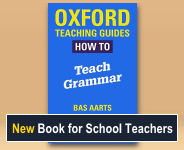Topic: Function
These resources cover different grammatical functions that apply to elements of clauses, such as Subject and Direct Object. Understanding how clauses are formed and how constituents work together is important in developing both close reading and effective writing skills.
Englicious contains many resources for English language in schools, but the vast majority of them require you to register and log in first. For more information, see What is Englicious?

